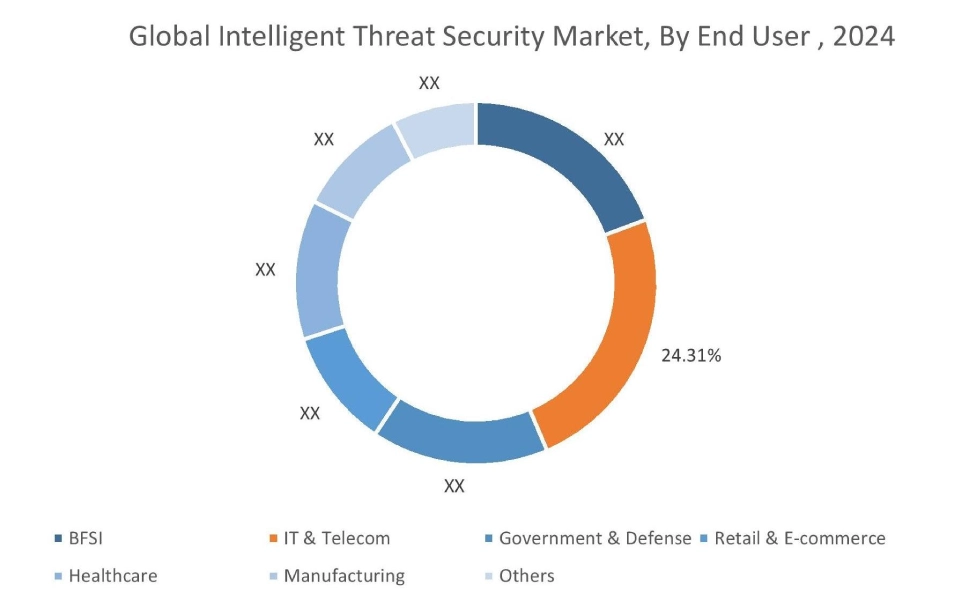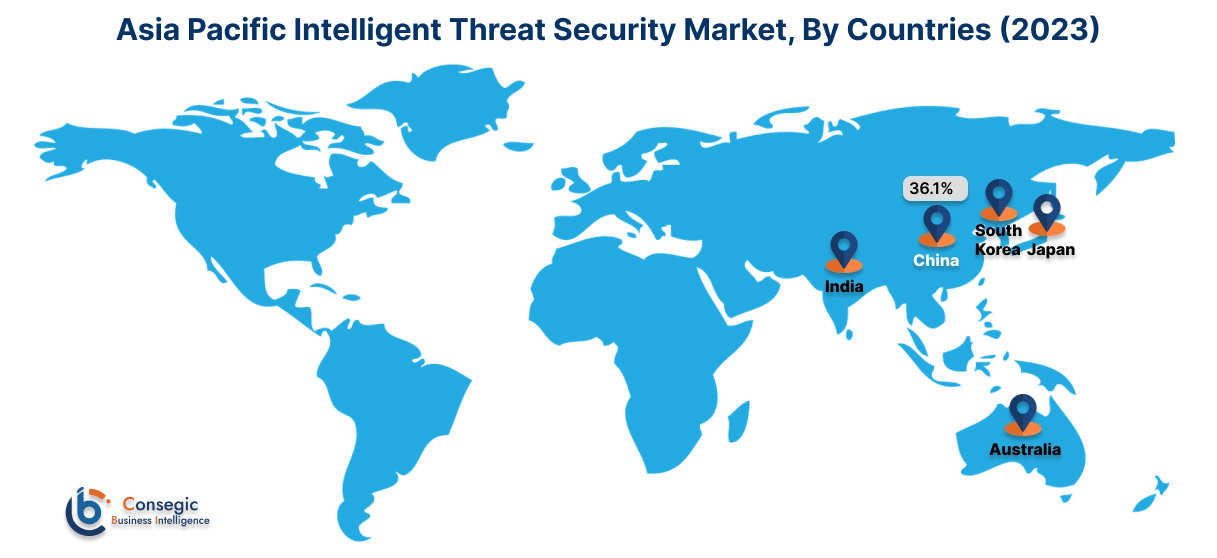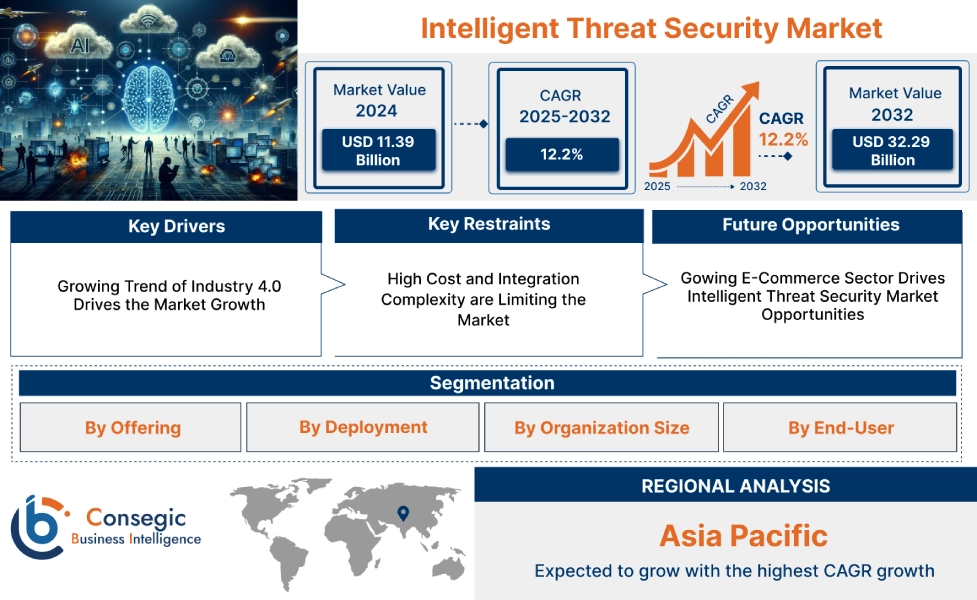Intelligent Threat Security Market Scope & Overview:
Intelligent threat security or cyber threat intelligence, is a cybersecurity approach that involves gathering, scrutinizing, and sharing information regarding potential and current cyber threats. Further, the threat security solutions are used for a wide range of applications in sectors including manufacturing, BFSI, healthcare, IT & telecom, and others. Further, main benefits of the solutions include faster incident response and enhanced vulnerability management. Furthermore, key factors driving the market include increasing use of artificial intelligence and machine learning to automate threat detection, adoption of cloud-based and hybrid-cloud infrastructures, and rapid growth of the Internet of Things (IoT).
Intelligent Threat Security Market Size:
Intelligent Threat Security Market is estimated to reach over USD 32.29 Billion by 2032 from a value of USD 11.39 Billion in 2024 and is projected to grow by USD 12.84 Billion in 2025, growing at a CAGR of 12.2% from 2025 to 2032.
How is AI Impacting the Intelligent Threat Security Market?
Artificial intelligence (AI) is changing the threat security sector by escalating the threat landscape as well as ensuring new defensive abilities. Cyber attackers are using artificial intelligence to create more sophisticated and scalable threats, such as deepfakes, phishing campaigns, and malware. Moreover, AI is an essential tool for defenders, enabling security solutions to examine massive volumes of data in real-time, foresee new attack patterns, and automate quick responses that are beyond human ability. Thus, the dual-use nature of artificial intelligence is driving the new security arms race, which is convincing organizations to adopt artificial intelligence-based defenses to fight against the threats enabled by the same technology.
Intelligent Threat Security Market Dynamics - (DRO) :
Key Drivers:
Growing Trend of Industry 4.0 Drives the Market Growth
There is an increasing emphasis on Industry 4.0 which is an essential driver for intelligent threat security market as it introduces a new threat landscape. Industry 4.0 creates several new entry points for cyberattacks through connecting operational technology systems to IT networks and internet. This conjunction exposes critical manufacturing processes and control systems to the sophisticated threats such as ransomware. Subsequently, there is an increased demand for intelligent security solutions that can provide a complete picture of IT as well as operational technology environments. Thereby, stopping operational disruption, protecting valued intellectual property, and guaranteeing the physical safety of industrial plants.
- For instance, according to Germany Trade & Invest, the country is implementing project "Industrie 4.0," which is focused on the complete digitalization of its manufacturing sector. Also, in 2021, a study by the Bitkom digital association found that 62% of companies in Germany are already employing technologies and solutions related to this initiative.
Thus, need to protect highly vulnerable, interconnected industrial environments from cyber threats contributes significantly to the intelligent threat security market size.
Key Restraints :
High Cost and Integration Complexity are Limiting the Market
High cost of security solutions and intrinsic complexity of integration are significant preventive factors for market growth. The significant investment compulsory for obtaining licenses, along with subscription fees as well as maintenance costs, often prohibits small and medium-sized enterprises as these enterprises have limited cybersecurity budgets. Additionally, integration of the advanced platforms with an organization's existing, and often legacy IT infrastructure is a complicated and time-consuming process. This in turn leads to compatibility problems, disruption of the ongoing operations, and need for specialized talent which results in rise of overall financial and operational burden and thereby limiting the market.
Future Opportunities :
Gowing E-Commerce Sector Drives Intelligent Threat Security Market Opportunities
The burgeoning e-commerce sector presents a significant opportunity for the intelligent threat security market, as the sheer volume of online transactions and sensitive consumer data makes it a prime target for cybercriminals. The increased use of digital payments, online shopping platforms, and loyalty programs creates a vast and complex attack surface, fueling the demand for advanced security solutions that can combat threats like payment fraud, account takeovers, and brand impersonation. This urgent need for robust protection to maintain customer trust and prevent financial losses is compelling e-commerce businesses to invest in real-time threat intelligence and fraud detection technologies.
- For instance, according to International Trade Administration, worldwide B2C e-commerce revenue is projected to reach USD 5.5 trillion by 2027, exhibiting a consistent 14.4% annual growth rate.
Thus, e-commerce businesses are investing in threat security solutions to protect sensitive consumer data which in turn drives intelligent threat security market opportunities.
Intelligent Threat Security Market Segmental Analysis :
By Offering:
Based on the offering, the market is segmented into solutions and services.
Trends in the Offering:
- Increasing emphasis on cloud-native services with robust APIs to ensure seamless scalability and integration which in turn drives the intelligent threat security market trends.
- Increasing focus on behavioral analytics to establish a baseline of normal behavior and flag anomalies which is expected to drive intelligent threat security market size.
Solutions accounted for the largest revenue share in the year 2024.
- Increasing use of artificial intelligence and machine learning to automate threat detection, analysis, and response to combat sophisticated attacks which is driving the intelligent threat security market share.
- Further, there is an increasing focus on Extended Detection and Response platforms that unify security across multiple domains in turn driving the market.
- Furthermore, growing shift from a reactive model to a proactive one by incorporating features like external attack surface management which in turn drives the intelligent threat security market trends.
- Thus, as per analysis, AI and ML integration, convergence into XDR platforms, and proactive security capabilities are driving the market.
Services is anticipated to register the fastest CAGR during the forecast period.
- Organizations are increasingly outsourcing their threat hunting and incident response requirements to managed detection and response providers which in turn drive the market.
- Further, increasing trend of offering specialized services to help companies manage security challenges of securing cloud infrastructure and data drives the market.
- Furthermore, increasing emphasis on implementing zero trust architectures drives the market growth.
- Therefore, based on analysis, managed detection and response, specialization in cloud security and adoption of a zero trust are anticipated to boost the market during the forecast period.
By Deployment:
Based on the deployment, the market is segmented into cloud-based and on-premise.
Trends in the Deployment:
- On-premise solutions offer organizations a greater degree of customization and control over security configurations which in turn drives the intelligent threat security market demand.
- Cloud-based platforms are leveraging AI and machine learning for advanced threat detection and automated response in turn driving the intelligent threat security market share.
Cloud-based accounted for the largest revenue share in the year 2024 and is anticipated to register the fastest CAGR during the forecast period.
- Increasing shift to digital transformation and the need for scalable, flexible security solutions drives the need for cloud based solutions.
- Further, solutions are becoming more API-driven to enable seamless, automated integration with existing cloud services which in turn drives the intelligent threat security industry.
- Furthermore, growing integration of cloud security posture management features which automatically detect and remediate misconfigurations and security vulnerabilities in turn driving the market.
- Thus, as per intelligent threat security market analysis, aforementioned factors are driving the market.

By Organization Size:
Based on the organization size, the market is segmented into large enterprises and small and medium enterprises.
Trends in the Organization Size:
- Small and medium enterprises are increasingly focusing on managed security service providers to gain access to expert-level threat intelligence which in turn drives the intelligent threat security market expansion.
- There is increasing awareness and a willingness to allocate more budget towards cybersecurity which propels the intelligent threat security market demand.
Large enterprises accounted for the largest revenue share in the year 2024 and is anticipated to register the fastest CAGR during the forecast period.
- Increasing investment by large enterprises on AI and machine learning, which in turn drives the market.
- Further, large enterprises are gradually integrating threat intelligence into their strategic decision-making, which in turn drives the intelligent threat security market growth.
- For instance, according to IBEF, India's retail market is projected to expand significantly, reaching USD 1.6 trillion by 2026 with a robust annual growth rate of 10%. The growing retail sector in turn will drive the market.
- Thus, based on analysis, AI and automation and integration of threat intelligence into business operations is driving the market.
By End-User:
Based on the end user, the market is segmented into BFSI, IT & telecom, government & defense, retail & e-commerce, healthcare, manufacturing, and others.
Trends in the End User:
- Increasing demand of zero trust frameworks by banks and financial institutions to secure their networks in turn driving the intelligent threat security market.
- Government & defense sector is focusing on intelligent threat security to defend against persistent and sophisticated cyberattacks which in turn drive the market.
IT & Telecom accounted for the largest revenue share of 24.31% in the year 2024.
- IT and telecom sector is focusing on securing complex supply chains from malicious software and hardware which in turn drives the intelligent threat security market growth.
- Further, rollout of 5G and edge computing is driving the need for intelligent threat security solutions which in turn drives the market.
- Furthermore, the IT and telecom sector is increasingly engaging in collaborative threat intelligence sharing to combat sophisticated cyberattacks which in turn drive the market.
- Thus, as per intelligent threat security market analysis, threat intelligence sharing, edge and 5G security, and supply chain security are driving the market.
Healthcare is anticipated to register the fastest CAGR during the forecast period.
- Increasing adoption of intelligent threat security to protect highly valuable and sensitive protected health information which in turn drives the market.
- Further, increasing trend of proliferation of connected medical devices which propels the intelligent threat security market expansion.
- Furthermore, upsurge of telemedicine is boosting the need for solutions that can secure remote patient monitoring and video consultations which in turn drive the market.
- Therefore, based on analysis aforementioned factors are driving the market.
Regional Analysis:
The regions covered are North America, Europe, Asia Pacific, Middle East and Africa, and Latin America.

Asia Pacific region was valued at USD 3.35 Billion in 2024. Moreover, it is projected to grow by USD 3.79 Billion in 2025 and reach over USD 9.73 Billion by 2032. Out of this, China accounted for the maximum revenue share of 28.48%. The market for intelligent threat security is mainly driven by rapid pace of digital transformation and surge in cyberattacks across various sectors. Additionally, growing e-commerce and retail sector is further driving the market.
- For instance, according to International Trade Administration, India is expected to have the fastest retail e-commerce globally between 2023 and 2027, boasting a CAGR of 14.1%. This will drive the need for enhancing security against cyber-attacks.

North America is estimated to reach over USD 11.04 Billion by 2032 from a value of USD 3.89 Billion in 2024 and is projected to grow by USD 4.38 Billion in 2025. The North American market is primarily driven by increasing adoption of cloud computing, IoT devices, and digital payments .
- For instance, in December 2024, Mastercard completed the acquisition of Recorded Future which is world's largest independent threat intelligence company. The strategic move is designed to boost Mastercard’s global digital defense by integrating Recorded Future’s AI-driven, real-time threat intelligence.
The regional analysis depicts that stringent government regulations and compliance standards, particularly in the BFSI and healthcare sectors in Europe are driving the market. Additionally, the factors driving the market in the Middle East and African region are increasing threat of cyberattacks targeting critical sectors such as energy and finance, and growing emphasis on regulatory compliance. Further, increasing industrialization, digital transformation, and sophistication of cyberattacks across the region is paving the way for the progress of market trends in Latin America region.
Top Key Players & Market Share Insights:
The global intelligent threat security market is highly competitive with major players providing solutions to the national and international markets. Key players are adopting several strategies in research and development (R&D), product innovation, and end-user launches to hold a strong position in the intelligent threat security industry. Key players in the global intelligent threat security market include-
- IBM Corporation (US)
- CiscoSystems Inc. (US)
- Huawei Technologies (China)
- Vmware, Inc. (US)
- Dell Technologies (US)
- AO Kaspersky Lab. (Russia)
- Microsoft (US)
- Palo Alto Networks (US)
- CrowdStrike (US)
- Fortinet, Inc. (US)
Recent Industry Developments :
Partnership
In October 2024, CrowdStrike partnered with Veriti, CardinalOps, and Nagomi Security, to drive the adoption of Falcon Threat Intelligence platform. The alliances were formed with an objective to automate critical security functions, including detection engineering, security posture management, and countermeasure deployment across various security tools.
Intelligent Threat Security Market Report Insights :
| Report Attributes | Report Details |
| Study Timeline | 2018-2031 |
| Market Size in 2031 | USD 32.29 Billion |
| CAGR (2024-2031) | 12.2% |
| By Offering |
|
| By Deployment |
|
| By Organization Size |
|
| By End User |
|
| By Region |
|
| Key Players |
|
| North America | U.S. Canada Mexico |
| Europe | U.K. Germany France Spain Italy Russia Benelux Rest of Europe |
| APAC | China South Korea Japan India Australia ASEAN Rest of Asia-Pacific |
| Middle East and Africa | GCC Turkey South Africa Rest of MEA |
| LATAM | Brazil Argentina Chile Rest of LATAM |
| Report Coverage |
|
Key Questions Answered in the Report
How big is the intelligent threat security market? +
The intelligent threat security market is estimated to reach over USD 32.29 Billion by 2032 from a value of USD 11.39 Billion in 2024 and is projected to grow by USD 12.84 Billion in 2025, growing at a CAGR of 12.2% from 2025 to 2032.
What specific segmentation details are covered in the intelligent threat security report? +
The intelligent threat security report includes specific segmentation details for offering, deployment, organization size, end user, and regions.
Which is the fastest segment anticipated to impact the market growth? +
In the intelligent threat security market, cloud based deployment is the fastest-growing segment during the forecast period.
What are the key trends in the intelligent threat security market? +
The intelligent threat security market is being shaped by several key trends including increasing use of artificial intelligence and machine learning to automate threat detection, adoption of cloud-based and hybrid-cloud infrastructures, and rapid growth of the Internet of Things (IoT).
Who are the major players in the intelligent threat security market? +
The key participants in the intelligent threat security market are IBM Corporation (US), AO Kaspersky Lab. (Russia), Microsoft (US), Palo Alto Networks (US), CrowdStrike (US), Fortinet, Inc. (US), Cisco Systems Inc. (US), Huawei Technologies (China), Vmware, Inc. (US), Dell Technologies (US) and others.

